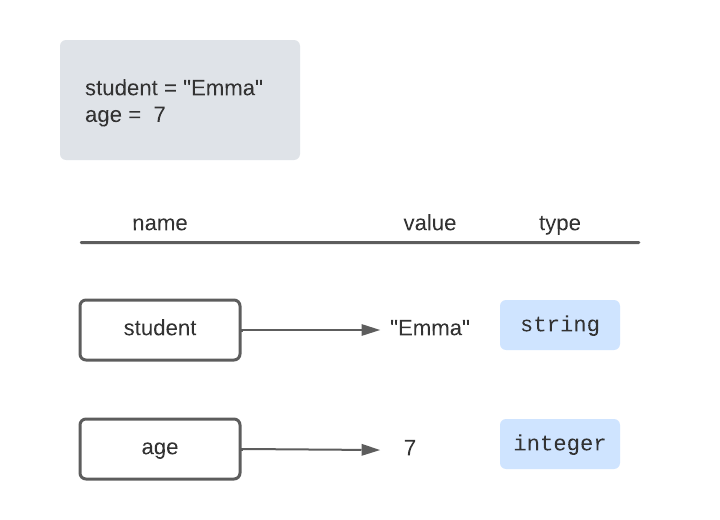Types and Files
Types
- every variable has a type
- types are figured out for you by Python
student = "Emma"
age = 7
Operations depend on the variable type
age = 7
student = 'Emma'
print(age + age)
print(student + student) 14
EmmaEmmaIf you think you have an integer but actually have a string…
age = '7'
print(age + age) 77If you have a string but wish you had an integer…
age = '7'
print(age + age) 77Reminder: convert the string to an integer using int()
age_converted_to_integer = int(age)
print(age_converted_to_integer + age_converted_to_integer) 14age = int(age)
print(age + age)
14If you have an integer but wish you had a string…
score = 10
output = "score: "
output += score ---------------------------------------------------------------------------
TypeError Traceback (most recent call last)
/var/folders/9x/cb134v3d2nb22_rksynbspqm0000gn/T/ipykernel_12650/4122253352.py in <module>
1 score = 10
2 output = "score: "
----> 3 output += score
TypeError: can only concatenate str (not "int") to strReminder: convert the integer to a string using str()
score = str(score)
output += score
print(output) score: 10example: sum_digits(s)
- sum all the digits in a string
def sum_digits(s):
# use the accumulator pattern
sum = 0
# loop over all the digits
for i in range(len(s)):
if s[i].isdigit():
sum += int(s[i])
return sum
sum_digits('abc4d5e10') 10def sum_contiguous_digits(s):
# use the accumulator pattern
sum = 0
substring = ''
# loop over all the digits
for i in range(len(s)):
if s[i].isdigit():
substring += s[i]
print(i,s[i],"this is a digit, so add it to substring")
elif len(substring) > 0:
print(i,s[i],"this is not a digit, so convert substring to an int", substring)
sum += int(substring)
substring = ''
if len(substring) > 0:
sum += int(substring)
return sum
sum_contiguous_digits('abc45e10') 3 4 this is a digit, so add it to substring
4 5 this is a digit, so add it to substring
5 e this is not a digit, so convert substring to an int 45
6 1 this is a digit, so add it to substring
7 0 this is a digit, so add it to substring
55for character in
- all this time we have been using
for i in range(len(s)):
# do something with character s- we could be using
for character in s:
# do something with character sexample: sum_digits(s) — using for character in
def sum_digits(s):
# use the accumulator pattern
sum = 0
# loop over all the digits
for character in s:
if character.isdigit():
sum += int(character)
return sum
sum_digits('abc4d5e10') 10example: right_left(s)
-
take a string, cut it in half (right half and left half)
-
make a new string that has “rightrightleftleft”
-
‘aabb’ -> ‘bbbbaaaa’
finding the middle of a string
s = 'aabb'
middle = len(s) / 2
print(middle)
s[middle] 2.0
---------------------------------------------------------------------------
TypeError Traceback (most recent call last)
/var/folders/9x/cb134v3d2nb22_rksynbspqm0000gn/T/ipykernel_12650/1260919677.py in <module>
2 middle = len(s) / 2
3 print(middle)
----> 4 s[middle]
5
6
TypeError: string indices must be integersinteger division
s = 'aabb'
middle = len(s) // 2
print(middle)
s[middle] 2
'b'def right_left(s):
middle = len(s) // 2
left = s[:middle]
right = s[middle:]
return right + right + left + left
right_left('aabb')
right_left('aabbb') 'bbbbbbaaaa'modular division
23 % 10 336 % 10 617 % 5 245 % 5 0example: crazy_str(s)
- first letter lowercase, second uppercase, and then continue alternating lowercase and uppercase
def crazy_str(s):
# accumulator pattern
result = ''
for i in range(len(s)):
if i % 2 == 0:
# even number
result += s[i].lower()
else:
# odd number
result += s[i].upper()
return result
crazy_str('WHAT is going on?') 'wHaT Is gOiNg oN?'Files
-
each file is a set of lines
-
each line is a sequence of characters
-
every line ends with a newline character ‘\n’ (same as hitting Return or Enter on keyboard)
-
create a file called hibye.txt:
Hi and↩️
Bye↩️A file is just a long string
- if you could read the entire file into a single string, it would look like this:
file_contents = "Hi and\nBye\n"- each
\nrepresents a newline character
Actually, this is easy to do
# open a file for reading
file = open('hibye.txt')
# the variable "file" is a file, just like "bit" was a bit and "image" was an image
# file.read() reads the entire file and returns a string
contents = file.read()
contents 'Hi and\nBye\n'Reading a file line by line
# in this block of code, set the variable 'file' to the file that is named 'hibye.txt'
with open('hibye.txt') as file:
# loop over all lines in a file
# looks a lot like "for pixel in image" and "for character in string"
count = 0
for line in file:
# use line in here
if count == 0:
print(line)
count += 1
print(f"I read {count} lines") Hi and
I read 2 lineswhy are there extra newlines?
- the first line is
Hi and\n - when you
print('Hi and\n'), you get a newline from the string, and then print adds an extra newline
strip()
- removes both leading and trailing whitespace characters in a string
- one of the most helpful functions you will use with files!
s = "Apples and\n"
print(s.strip())
word = " \t bananas \n "
print(word.strip())Apples and bananas
with open('hibye.txt') as file:
for line in file:
# remove whitespace
print(line.strip()) Hi and
Byecarriage returns and newlines
-
MacOS ends lines with
\n— newline character -
Windows ends lines with
\r\n— carriage return character and newline character -
newline is also called line feed
-
\r\nis called CRLF (carriage return line feed) -
carriage return returns to the beginning of the current line, line feed moves to the next line)
Python handles this for you
- when you use
for line in file, Python automatically detects both\nand\r\n
remember crazy_str(s)?
with open('hibye.txt') as file:
for line in file:
# change the line into a crazy string
crazy_line = crazy_str(line)
# don't print anything at the end of the line
print(crazy_line, end='') hI AnD
bYe